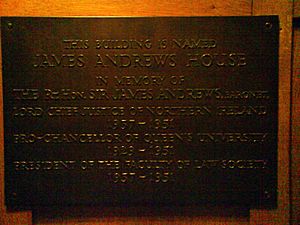Sir James Andrews, 1st Baronet facts for kids
Sir James Andrews was an important judge in Northern Ireland. He was born on January 3, 1877, and passed away on February 18, 1951. He was the brother of J. M. Andrews, who became a Prime Minister, and Thomas Andrews, who was the designer of the famous ship, the Titanic.
Quick facts for kids
Sir James Andrews, 1st Baronet
|
|
|---|---|

Plaque sited in the Queen's University of Belfast School of Law. It reads; "This building is named James Andrews House in memory of the Rt. Hon. Sir James Andrews, Baronet, Lord Chief Justice of Northern Ireland 1937–1951, Pro-Chancellor of Queen's University 1929–1951, President of the Faculty of Law Society 1937-1951"
|
|
| Born | January 3, 1877 Comber, County Down, Ireland
|
| Died | February 18, 1951 (aged 74) Comber, County Down, Ireland
|
| Nationality | Irish |
| Education | Royal Belfast Academical Institution |
| Alma mater | Trinity College Dublin |
| Spouse(s) | Jane Lawson Ormrod (m. 1922-1951) |
| Children | 3 |
| Family |
|
Early Life and Education
James Andrews was born in a town called Comber in County Down. He was the third son of Thomas Andrews, who owned a flax spinning business. His mother was Eliza, and her brother was William Pirrie, 1st Viscount Pirrie, a very important businessman.
James was also the great-grandson of William Drennan. Drennan was a leader of a group called the United Irishmen.
James went to school at the Royal Belfast Academical Institution. After that, he studied at Stephen's Green School in Dublin. He then attended Trinity College Dublin. There, he did very well in his studies. He won awards for his work in law and graduated in 1899. He was also a top student and leader of the College Historical Society.
Outside of his studies, James loved sports. He enjoyed shooting, playing golf and cricket, and sailing. He especially liked sailing on Strangford Lough.
In 1922, James Andrews married Jane Lawson Ormrod. Jane already had three children from her first marriage.
A Career in Law
Even though his family ran factories, James chose to study law. His uncle, William Drennan Andrews, was also a lawyer and a judge. In 1900, James became a barrister in Ireland. This meant he could argue cases in court.
He quickly became a successful lawyer. His uncle, the judge, helped him a lot in his early career. In 1918, James became a King's Counsel (KC). This is a special title for experienced lawyers.
In 1921, he was made a Lord Justice of Appeal. This was a high position in the new Supreme Court of Northern Ireland. This court was set up under a law passed in 1920. Another lawyer, Maurice Healy, thought James was a better judge than his uncle. He felt James was fairer and did not give out very harsh sentences.
In 1924, James joined the Privy Council of Northern Ireland. This is a group of important advisors. He also became a member of the Inn of Court of Northern Ireland in 1926.
James was involved with the Queen's University of Belfast. He was on its main governing body from 1924. He also served as a pro-chancellor from 1929. This meant he helped lead the university.
In 1937, James became the Lord Chief Justice of Northern Ireland. This was the highest judicial position in Northern Ireland. He held this important role until he passed away. In 1938, his old university gave him an honorary law degree. On July 6, 1942, he was given the title of a baronet. This is a special honor from the King.
Sir James Andrews died in Comber in 1951. The title of baronet ended with him, as he had no sons to inherit it.
Today, the School of Law at Queen's University of Belfast has a building named after him. It is called Sir James Andrews House.

